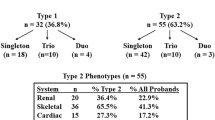Abstract
DiGeorge syndrome in humans is charaterized by immunodeficiency, heart defects, mental retardation and facial dysmorphism; cytogenetic analysis has shown that deletions at 22q11 occur in approximately 25% of cases. To generate DNA markers from this region, we have microdissected and microcloned band q11 of human Chromosome (Chr) 22. Nineteen thousand clones were obtained from material dissected from 20 chromosome fragments. Seventeen of 61 clones analyzed (28%) were repetitive, 27 (44%) gave no signal, and 17 (28%) detected single copy sequences of which ten mapped to Chr 22. Two of these were found to be deleted in patients with DiGeorge syndrome and either monosomy for 22q11-pter or visible interstitial deletions of 22q11. These two markers are also hemizygous in patients with no visible chromosomal abnormality, demonstrating that submicroscopic deletions are common in DiGeorge syndrome patients.
Similar content being viewed by others
References
Birnboim, H.C. and Doly, J.: A rapid alkaline extraction procedure for screening recombinant plasmid DNA. Nucl Acids Res 7: 1513–1523, 1979.
Bockman, D.E. and Kirby, M.L.: Dependence of thymus development on derivatives of the neural crest. Science 223: 498–500, 1984.
Buiting, K., Neumann, M., Lüdecke, H-J., Senger, G., Claussen, U., Antich, J., Passarge, E., and Horsthemke, B.: Microdissection of the Prader-Willi syndrome chromosome region and identification of potential gene sequences. Genomics 6: 521–527, 1990.
Carey, A.H., Roach, S., Williamson, R., Dumanski, J.P., Nordenskold, M., Collins, V.P., Rouleau, G., Blin, N., Jalbert, P., and Scambler, P.J.: Localisation of 27 DNA markers to the region of human chromosome pter-22q11 deleted in patients with the DiGeorge syndrome and duplicated in the der22 syndrome. Genomics 7: 299–306, 1990.
Conley, M.E., Beckwith, J.B., Mancer, J.F.K., and Tenkhoff, L.: The spectrum of DiGeorge syndrome. J Pediatr 94: 833–890, 1979.
Emanuel, B.S.: Molecular cytogenetics: Toward dissection of the contiguous gene syndromes. Am J Hum Genet 43: 575–578, 1988.
Feinberg, A.P. and Vogelstein, B.: A technique for radiolabelling DNA restriction endonuclease fragments to high specific activity. Anal Biochem 132: 6–13, 1983.
Fibison, W.J., Budarf, M., McDermid, H., Greenberg, F., and Emanuel, B.S.: Molecular studies of DiGeorge syndrome. Am J Hum Genet 46: 888–895, 1990.
Greenberg, F., Crowder, W.E., Paschall, V., Colon-Linares, J-C., Lubianski, B., and Ledbetter, D.: Familial DiGeorge syndrome and associated partial monosomy of chromosome 22. Hum Genet 65: 317–319, 1984.
Greenberg, F., Elder, F.F.B., Haffner, P., Northrup, H., and Ledbetter, D.: Cytogenetic findings in a prospective series of patients with DiGeorge anomaly. Hum Genet 43: 605–611, 1988.
Gregory, C.A., Kirkilionis, A.J., Greenberg, C.R.M., Chudley, A.E., and Hamerton, J.L.: Detection of molecular rearrangements in Prader-Willi syndrome patients by using genomic probes recognising four loci within the PWCR. Am J Med Genet 35: 536–545, 1990.
Keppen, L.D., Fasules, J.W., Burks, A.W., Gollin, S.M., Sawyer, J.R., and Miller, C.H.: Confirmation of autosomal dominant transmission of the DiGeorge malformation complex. J Pediatr 113: 506–508, 1988.
Kirby, M.L., Gale, T.F., and Stewart, D.E.: Neural crest cells contribute to aorticopulmonary septation. Science 220: 1059–1061, 1983.
Lüdecke, H-J., Senger, G., Claussen, U., and Horsthemke, B.: Cloning defined regions of the human genome by microdissection of banded chromosomes and enzymatic amplification. Nature 338: 348–350, 1989.
Lüdecke, H-J, Senger, G., Claussen, U., and Horsthemke, B.: Construction and characterisation of band-specific DNA libraries. Hum Genet 84: 512–516, 1990.
Muller, W., Peter, H.H., Wilken, M., Juppner, H., Kallfelz, H.C., Krohn, H.P., Miller, K., and Reiger, C.H.L.: The DiGeorge syndrome. I. Clinical evaluation and course of partial and complete forms of the syndrome. Eur J Pediatr 147: 496–502, 1988.
Rohn, R.D., Leffel, M.S., Leadem, P., Johnson, D., Rubio, T., and Emmanuel, B.: Familial third-fourth paryngeal pouch syndrome with apparent autosomal dominant transmission. J Pediatr 105: 47–51, 1984.
Scambler, P.J., Carey, A.H., Wyse, R.K.H., Roach, S., Dumanski, J.P., Nordenskjold, M., and Williamson, R.: Microdeletions within 22q11 associated with sporadic and familial DiGeorge syndrome. Genomics 10: 201–206, 1991.
Senger, G., Lüdecke, H-J., Horsthemke, B., and Claussen, U.: Microdissection of banded human chromosomes. Hum Genet 84: 507–511, 1990.
Author information
Authors and Affiliations
Rights and permissions
About this article
Cite this article
Carey, A.H., Claussen, U., Lüdecke, HJ. et al. Interstitial deletions in DiGeorge syndrome detected with microclones from 22q11. Mammalian Genome 3, 101–105 (1992). https://doi.org/10.1007/BF00431253
Received:
Accepted:
Issue Date:
DOI: https://doi.org/10.1007/BF00431253




